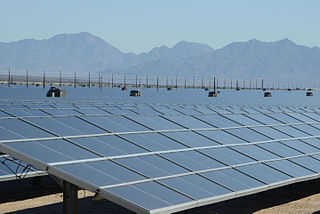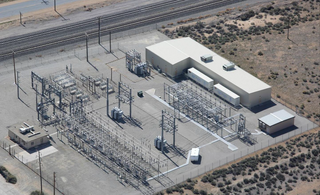
Solar Energy Generating Systems (SEGS) is a concentrated solar power plant in California, United States. With the combined capacity from three separate locations at 354 megawatt (MW), it was once the world's second largest solar thermal energy generating facility, until the commissioning of the even larger Ivanpah facility in 2014. It consisted of nine solar power plants in California's Mojave Desert, where insolation is among the best available in the United States.

Many countries and territories have installed significant solar power capacity into their electrical grids to supplement or provide an alternative to conventional energy sources. Solar power plants use one of two technologies:

Solar power is a fast-growing industry in Australia. As of March 2023, Australia's over 3.44 million solar PV installations had a combined capacity of 30,465 MW photovoltaic (PV) solar power, of which at least 3,953 MW were installed in the preceding 12 months. In 2019, 59 solar PV projects with a combined capacity of 2,881 MW were either under construction, constructed or due to start construction having reached financial closure. Solar accounted for 12.4% of Australia's total electrical energy production in 2021.

The Nellis Solar Power Plant is a 14-megawatt (MW) photovoltaic power station located within Nellis Air Force Base in Clark County, Nevada, northeast of Las Vegas. The power plant was inaugurated in a ceremony on December 17, 2007, with Nevada Governor Jim Gibbons activating its full operation. On average, it has since generated 32 gigawatt-hours of electricity annually and supplied more than 25% of the power used at the base.

Graveney is a village and former civil parish, now in the parish of Graveney with Goodnestone, in the Swale district, in Kent, England. It is located between Faversham and Whitstable. The main part of the village is located along the intersection of Seasalter Road, Sandbanks Road and Head Hill Road, which is surrounded by farmland. The rest of the village is dispersed amongst this farmland. In 1961 the parish had a population of 305.

Solar power represented a very small part of electricity production in the United Kingdom until the 2010s when it increased rapidly, thanks to feed-in tariff (FIT) subsidies and the falling cost of photovoltaic (PV) panels.
A photovoltaic system, also PV system or solar power system, is an electric power system designed to supply usable solar power by means of photovoltaics. It consists of an arrangement of several components, including solar panels to absorb and convert sunlight into electricity, a solar inverter to convert the output from direct to alternating current, as well as mounting, cabling, and other electrical accessories to set up a working system. It may also use a solar tracking system to improve the system's overall performance and include an integrated battery.

The use of solar energy began in Israel in the 1950s with the development by Levi Yissar of a solar water heater to address the energy shortages that plagued the new country. By 1967 around 5% of water of households were solar heated and 50,000 solar heaters had been sold. With the 1970s oil crisis, Harry Zvi Tabor developed the prototype of the solar water heater now used in over 90% of Israeli homes. There are over 1.3 million solar water heaters installed as a result of mandatory solar water heating regulations.

Solar power has been growing rapidly in the U.S. state of California because of high insolation, community support, declining solar costs, and a renewable portfolio standard which requires that 60% of California's electricity come from renewable resources by 2030, with 100% by 2045. Much of this is expected to come from solar power via photovoltaic facilities or concentrated solar power facilities.

The energy sector in Hawaii has rapidly adopted solar power due to the high costs of electricity, and good solar resources, and has one of the highest per capita rates of solar power in the United States. Hawaii's imported energy costs, mostly for imported petroleum and coal, are three to four times higher than the mainland, so Hawaii has motivation to become one of the highest users of solar energy. Hawaii was the first state in the United States to reach grid parity for photovoltaics. Its tropical location provides abundant ambient energy.

The Desert Sunlight Solar Farm is a 550-megawatt (MWAC) photovoltaic power station approximately six miles north of Desert Center, California, United States, in the Mojave Desert. It uses approximately 8.8 million cadmium telluride modules made by the US thin-film manufacturer First Solar. As of Fall 2015, the Solar Farm has the same 550 MW installed capacity as the Topaz Solar Farm in the Carrizo Plain region of Central California, making both of them tied for the second largest completed solar plants by installed capacity.

A photovoltaic power station, also known as a solar park, solar farm, or solar power plant, is a large-scale grid-connected photovoltaic power system designed for the supply of merchant power. They are different from most building-mounted and other decentralized solar power because they supply power at the utility level, rather than to a local user or users. Utility-scale solar is sometimes used to describe this type of project.

Solar power in Minnesota expanded significantly in the early 2010s as a result of the cost decrease of photovoltaics and favorable policies. By 2016, it began to grow quickly.

Solar power in New Zealand is increasing in capacity, despite no government subsidies or interventions being available. As at the end of December 2022, New Zealand has 255 MW of grid-connected photovoltaic (PV) solar power installed, of which 65 MW (25%) was installed that year. In the 12 months to September 2022, 249 gigawatt-hours of electricity was estimated to have been generated by grid-connected solar, 0.57% of all electricity generated in the country.
WIRSOL Solar AG is an international solar energy provider, specialized in the planning, financing, construction and maintenance of solar power plants of any size. The headquarters of the company is in Germany. Further company offices are located in Spain, Italy, Great Britain, Belgium, Switzerland, Canada, USA, China, Malaysia and the Maldives.
In 2022 Chile produced about 18% of its electricity from solar power, up from 7% in 2018. As of 2022, Chile produces the highest percentage of its electricity from solar in the world. At the end of 2021 Chile was ranked 22nd in the world in terms of installed solar energy.

A battery storage power station is a type of energy storage power station that uses a group of batteries to store electrical energy. Battery storage is the fastest responding dispatchable source of power on electric grids, and it is used to stabilise those grids, as battery storage can transition from standby to full power in under a second to deal with grid contingencies.
Gannawarra Solar Farm is a photovoltaic solar power station in the Gannawarra Shire, 13 kilometres (8.1 mi) west of Kerang in the Australian state of Victoria. It generates up to 60 MWdc electricity and exports up to 50.61 MWAC to the National Electricity Market at 66 kV.
The Australia–Asia Power Link (AAPowerLink) is a proposed electricity infrastructure project that is planned to include the world's largest solar plant, the world's largest battery, and the world's longest submarine power cable. A solar farm in the Northern Territory of Australia, will produce up to 20 gigawatts of electricity, most of which will be exported to Singapore, and at a later point Indonesia, by a 4,500 km (2,800 mi) 3 GW HVDC transmission line. A 36-42 GWh battery is planned to store energy to level energy availability as sunlight varies throughout the day.
















